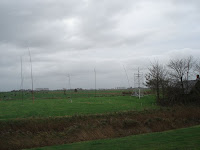I've had it with digimode interfaces that don't work or that only work sometimes or under some circumstances. The new JTDX and WSJT-X software requires a variable audio input as the audio input slider has been removed. Sometimes the audio slider in the computer software just isn't working well like in my old laptop. I've been searching for a commercial one, but if you want something with variable input/output they are not cheap.
So I decided to make another modem, a very simple one that use the VOX in the FT817 for TX switching. I'm not the first to try that and there is even a modification for the
FT817 to activate the VOX on the backside mini DIN connector which is originally not functioning with VOX, only on the mike input. That mod can be done but you need to remove the complete "motherboard" of the FT817 and I find that too risky. So I use the mini DIN connection for receive and the RJ45 mike input for transmit, this has been done before by others. Just to be shure I would have a clean signal I completely isolated the computer/radio with 1:1 audio transformers and I use small caps to ground to completely remove any RF. To couple the audio I place 2 electrolitic caps in in and output to block any DC. Things should be good that way I thought. Well, it did work when completely on batteries.

But when I connected the laptop power supply the radio goes in constant TX till I switch off the VOX. I really didn't know why in the first place but it then occured to me I forgot to connect ground connections together on both sides. After I soldered some extra wires the problem seems to be solved in the first place, at least on my base antenna. However, I still have issues with the magnetic loop connected. So I changed the RG58 coax into Aircell7. I don't trust RG58 at all and had a lot of problems with it in the past, but this time it didn't solve the problem. Monitoring with my IC-706 let me know that as soon as I touch the power supply connector VOX jumps in and radio transmits even without connecting the laptop to the power supply!!! And when I plug the connector in the laptop I get a very large hum on my audio. It was obviously a power supply problem and solved it by a extra "line filter" made from a large ferrite clamp.
After playing with it a while I didn't like the TX volume control, it seems te laptop does have a large output volume and to get a good ALC reading I need at least a very low output volume to actually control it with the potmeter, So I ad a 100K potmeter in series with the 20K potmeter inside to have better control over it.
Below the diagram of the interface if anyone likes to replicate it. Everything is made from scrap parts. I used a housing from a previous interface project, DIN connector with wire from a mouse, RJ45 connector with wire from a old network cable, Jack plugs found in my electronic garbage box, potmeters, knobs and capacitors from a broken CB radio.
I tested on the vertical with WSPR on 20m last sunday and results are promising. However, the main test would be with the loop antenna inside the house or garage or anywhere I want and on battery power as all this is for portable use. Today (a week later!) I had the opportunity to test it again on 20m and with the magnetic loop in a corner of my shack. The results for a few hours in the afternoon:
I was only received in Spain and Italy but I think a RTTY contest was disturbing 20m WSPR receive. However my receive did very well!
The setup: My old laptop with WSJT-X. FT817 with on top my new audio interface and the ZLP electronics CAT modem so I can control the radio with the computer. It works well like this. I tried FT8 on 30m but my computer is just too slow for it. However it looks like FT8 is a better propagation indicator compared to WSPR these days! So unfortunate JT65/JT9 is not as populair as before.
While testing my magloop I was on FT8 with my base station and found the 12m band wide open.
Before attending the 12m band I was looking at 6m and 10m. I threw out a few CQs but nothing came back. However, I was received in Reunion Isl. as you can see on the map (pink spot).
















































